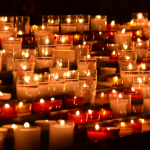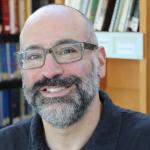By Gregory
Human beings have always been religious – there is something about being human that predisposes us toward religious behavior and expression. Therefore, it’s valuable to explore the essential nature of religion as a way of better understanding ourselves as well as our chosen traditions.
Religion is an integrated way of looking at the world. By integrated, I mean that religion is more than a complex explanation of the nature of reality – the sciences do a relatively good job of achieving that. Rather, religion goes beyond the sciences and integrates human knowing and experiencing into a meaningful/ purposeful framework – a worldview.
In its integrative approach, religion tends to have six distinct components. These parts have been noted by various religious thinkers, including Tillich, Armstrong, Eliade, Smart, Smith, and others. These six components are usually divided into two categories:
Theory/Thinking
Myth/Narrative – a set of sacred stories that express core insights into reality, human nature, and human meaning and purpose. These narratives provide a sense of place and belonging in the world. By calling these stories myths, we are not claiming they are fiction. However, we may recognize that their truth may not be literal in every detail. For example, the story of the victory at Jericho in the Old Testament conveys certain mythic truths about tribal identity, cultural dominance, and social advancement attributed to Divine action. However, the notion of the sun standing still for hours is likely not literally or scientifically true, but meant to speak to the people of the day in some manner. Therefore, myths contain truth, but not always historical or scientific truth as the modern mind understands these.
Doctrine/Teaching – a set of wisdom teachings that further structure one’s worldview in accord with myths. Such core teachings can range from explanations of proscribed behavior (sin) to necessary communal structures, to assertions about the nature of the Divine, the Universe, and human kind.
Ethical Theory/Purpose – a subset of doctrine is a specific way of living – a set of ideals put forth that if accepted and acted upon are intended to lead to a good and meaningful life. These practices are the logical result of core teachings – in other words, live this way because that is who we are and meant to be.
Practice/Action
Ritual/Liturgy – myth and core teaching are reinforced through rituals and liturgies – ceremony and repeated actions that dramatically and poetically represent mythic truths in a transformative fashion. Continued participation in ritual and liturgy therefore helps an individual internalize a religious worldview, fomenting psychological formation and change.
Symbol/Icon – religions create symbols that are invested with the meaning from the core worldview – examples of this are easy to see – the Cross in Christianity, a Menorah in Judaism, the Dharma wheel in Buddhism, etc. Symbols can be powerful and when meditated upon empower further psychological formation.
Community/Structure – nearly all religion is communal in its basic aspect – its message is tribal or universal, and therefore involves a people who are set aside to live in a certain manner. The community’s myths, symbols, values, and rites give it an identity that is intended to stand out from others in the shared region and culture.
These essential components of religious worldview can be more clearly understood with concrete examples:
Christianity’s myths involve Jesus as the incarnation of the God of Israel as the fulfillment of the Covenant and a means of ultimate salvation – Jesus enters human history to achieve the final redemption of the human family through his sacrifice on the Cross. The cross takes on central symbolic value, representing the life of kenotic love we are called to live. Jesus’ teachings are then reinforced through liturgy (including art, music, poetry, etc.) as well as doctrines that further explain their meaning.
Judaism’s central myth is the Exodus, where God liberates his chosen people from slavery in Egypt, setting them free to enter into a deeper, more meaningful Covenantal relationship with him as an example to all peoples. The Menorah – the seven branched oil lamp – symbolizes the light of God and Wisdom standing before the Holy of Holies in the Temple, as well as the primal number of days in God’s act of creation.
Analogously, even the secular worldview has religious aspects to it – evolution results in human life, the purpose of which is to live fully. What constitutes a good and full life differs, but symbols and rituals still abound – think of the $, notions such as progress and success, a large home in the suburbs, certain consumer brands, and the rituals of career, shopping, and consuming. Many people attempt to find their ultimate meaning in such things.
These short explanations of a religion’s overall thrust can be adjusted depending on one’s particular approach and metaphysics. For example, if one is invested in notions that their myths are revealed by an active, involved personal God – then their interpretation of myth, ritual, symbol, and teaching will likely take on a more supernatural flavor.
I offer these distinctions to help our ongoing conversations and to provoke thinking and your comments. Looking forward to hearing your thoughts on the above.











